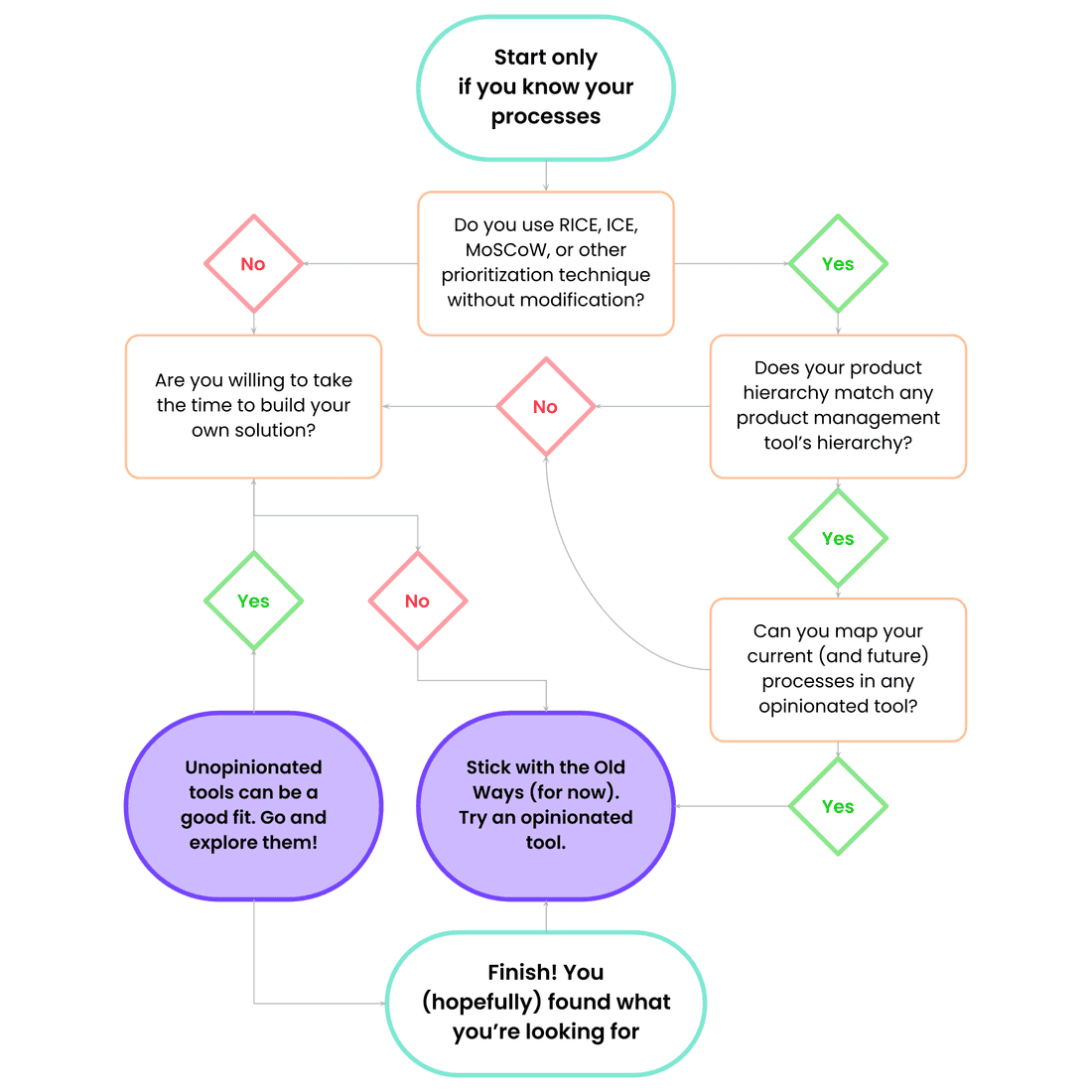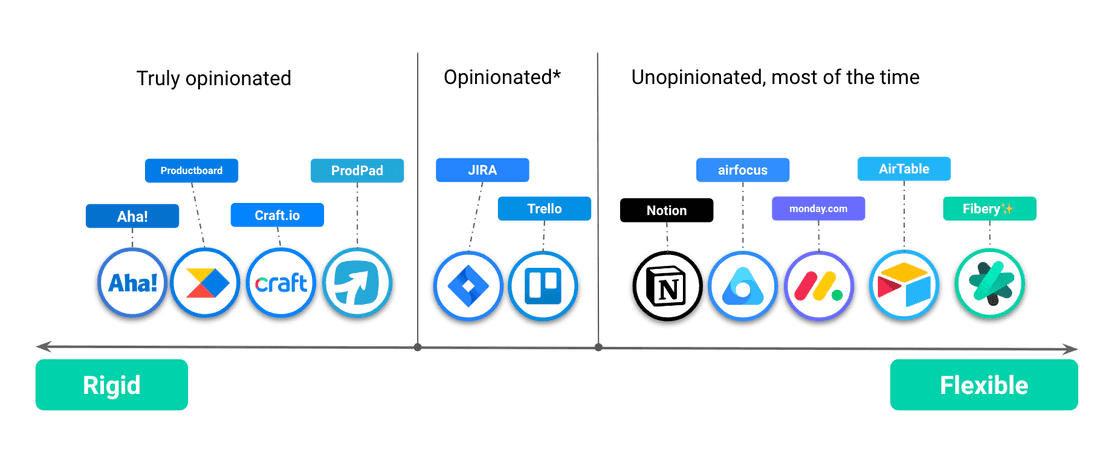Opinionated or Unopinionated: What Product Management Tool Should You Choose?
Great product management tools are opinionated. Or they aren’t: this is clearly a myth. But they are on the rise, so that’s good, right?
Opinions are like belly buttons. Everyone has one. Especially when it comes to the grand debate of opinionated vs. unopinionated systems. You see it every day: it’s McDonald’s vs. Subway, microwave ovens vs. conventional ovens, macOS vs. Linux, iOS vs. Android, or, dare we say, Productboard vs. Fibery.
In this article, we dissect the basic terms and explore the underlying philosophy to help you choose the perfect product management tool. Let’s dive in.
Binding freedom or restrictive simplicity?
In the heyday of software development, most of the tools we used for work had a tendency to be more unopinionated (by the standards of the time, at least). Microsoft OSs, for instance, allowed for a great degree of flexibility: if you had a clear idea of how you wanted to work, you could build your own suite of products and setups with a high degree of customization. It came with a steeper learning curve and it took time to get things to work.
Slowly but surely, though, opinionated software started rearing its head. Widespread adoption, increased competition, and probably just the nature of things in software development all pushed innovation toward simplified end products. Why have infinite freedom when you can get better (business) results with higher efficiency thanks to a more restrictive ecosystem? You don’t really have to look further than Apple.
Yes, the most popular tools are opinionated and collaborative, heralds of a new era are already with us. No-code tools currently mean a fresh new alternative in many areas even though they form a hip minority opposing giants like Salesforce, Google’s productivity tools, or MS Office.
Opinionated vs. unopinionated software
Okay, let’s stop for a breather. We are close. Let’s see first how you can identify an opinionated tool:
- It tells you how to do stuff. You only need to think about what you want to do. It imposes restrictions on your workflow and guides your hand heavily to do things the way it was designed to do.
- It’s easy to learn. You can get started in a few hours to days. Tools designed to get you to value fast cater to your intent: they look, feel, and sound familiar.
- It comes with a low degree of customization. You can’t really tailor it to your needs. Sure, you’ll have filters and custom views, but the system is already set up to work in a certain way. The inner workings of the tool will never reveal itself to you by design.
Unopinionated software is pretty much the opposite. In other words:
- It gives you a sandbox. Zero restrictions, near-infinite freedom. You need to know how you want to do things before you actually do them. Or you’ll be lost and clueless, often failing to find value in the tool.
- It’s tough to learn. You won’t hit the ground running in hours. First, you have to set up the tool the way you want to use it. This takes effort.
- It can be customized. Dream it and implement it. Why have (and pay) for features and functions you’ll never need? Build from scratch and mold the tool the way you want to use it.
Does this mean product management tools should be either this or that? The answer is, as you might expect, not that simple.
Process first, tool second
If one does not know to which port one is sailing, no wind is favorable.
You probably came here trying to find out which opinionated or unopinionated product management tool. We’ll have to disappoint you. Your first task is to know if you need a new tool at all. If you’ve already got stuck with the limitations of your current product management software, it might be a good sign to switch, and similarly, if you are scaling your process and/or organization, flexibility, and integrations (thus, an unopinionated tool) will help. There are plenty of things to consider, so we’ve put this picture together to help you out:

The PM’s take
The choice between opinionated and unopinionated software is not an easy one. For some processes, opinionated is good. You just get some tool, get used to it, and get things done. However, with time you start to see limitations, your process evolves, and the tool may no longer fit. This is the moment when you should try unopinionated software. It will help you explore your ideas and set things your way. The best unopinionated tool has no compromises and should be as rich as a tailored tool but with much more flexibility. Such tools are hard to build and hard to find, but they do exist.
Michael Dubakov, CEO at Fibery
Opinionated vs. unopinionated tools in product management
You are finally here. It’s either because you scrolled through the build-up or were moderately happy with a long preface. Either way, it’s high time we see clearly through the jungle of product management tools.
When you want to rank product management tools, first we need to dispel a false dichotomy. There’s hardly a truly opinionated tool and, similarly, there’s no fully unopinionated tool for product management. If we wanted to be cynical - and why wouldn’t we want that - we’d say there’ll always be an opinion dominating your tool: it’s either yours or the developer’s.

Truly opinionated
These product management tools leave little wriggling room. They offer an array of features and serve a limited amount of use cases with a low degree of customization.
A niche product management tool in the US, primarily used by healthcare, roadmapping, prioritization, and delivery management are some of the fortés of Aha!. An adept of the Pragmatic Framework, this tool will either fit your processes well or cause a lot of pain with its rigid hierarchy and processes. Still, it does come with a customizable interface, which makes the user experience more pleasant.
Another big player on the block. Productboard is good at backlog management, prioritization, feedback management, and roadmapping. This is also a tool built for product managers, which means that, if it fits your specific use case, you’ll have a field day, but if it doesn’t, it’ll be a bumpy ride.
Craft.io
Craft is a highly opinionated tool that builds upon best practices from the world of product development. Want to prioritize according to RICE, MoSCow, or some other method? Craft comes with a bunch of preset views (called Guru Views), so if you are used to widespread concepts, you probably found your match. The moment you want to impose your will (i.e. opinion), though, you’ll find the tool extraordinarily restrictive and rigid.
ProdPad
This product management tool subscribes to Lean development principles. As such, if you want to prioritize, validate, and iterate on product ideas while providing features to support this approach, you will find ProdPad a handy tool. If, however, you wanted to bring your own ideas to the table, suffering would entail.
Opinionated with an asterisk
The following product management tools come with an opinion, but they can also be a bit more flexible depending on your use case.
JIRA
Nobody has ever been fired for choosing JIRA. Tracking, planning, backlog management, it does it all. You get a finite degree of freedom, but if you subscribe to Agile principles, it will excel most - which means it also falls closer to the opinionated end of the spectrum.
Trello
Love Kanban? You’ll love Trello. Use Power-Ups to customize your boards, and ace low-level product management on any given day. The moment you want something more complicated or something outside the realm of Kanban, you might have to move more to the right on the opinionated spectrum.
Unopinionated, most of the time
This set of product management software gives you a blank slate and take pride in how flexible and powerful they are. It might take you some time to set up your ideal process, but if you have an exact idea in your head, the pros will always outweigh the cons.
Known for being Excel on steroids (and for its recent enterprise move). Airtable lets you kick things off with a single spreadsheet, and as you create more tables, you can also define the relation between them. We’re labeling Airtable unopinionated as it doesn’t force any paradigm on you unless you consider having a sheet as a blank canvas being opinionated.
This no-code tool allows you to create and connect workspaces: its minimalistic approach offers a seemingly endless canvas. Remember the notion of binding freedom? This tool understands that with great power comes great responsibility, so your canvas is finite, eventually. The clean and uniform approach of the tool (everything’s a page) also means that you can’t build hierarchies of databases. Ironically, the freedom Notion offers also caps your opportunities to create a truly complex system.
airfocus
This tool takes pride in being the world’s first modular product management tool. This means it’s highly flexible. It also means you’ll be facing a steep learning curve. As a relatively fresh tool on the market, airfocus can lack certain features, but thanks to its unopinionated approach, it can turn into a powerful tool in your hands.
Another major contender in our enumeration. Monday is a feature-rich tool that swarms you with workspaces, views, integrations, and automations, all with the power of flexibility. The catch? Similarly to Notion, building a complex system will come with tradeoffs. Connections between boards, epics, features, etc. push you to come up with workarounds.
Flexibility and customization above all: Fibery simply lets you cook (if you know how you want to cook). You can build any system with any level of complexity thanks to connected databases. And it doesn’t stop there: it grows with your organization, so you can start off with a rudimentary system and expand it as your company’s processes multiply and deepen. The flip side? You really have to know what you want from it. And it takes time to set up. Still, Fibery welcomes your opinion without contesting it or giving you one.
Closing remarks
At this point, you should have a clear picture if you need an opinionated or unopinionated product management tool. There are several criteria that help you find your actual tool (probably worthy of its own article) - here’s a quick glimpse into a few of them:
- Integrations. Is the tool tightly integrated with your company’s engineering tool? What about Go-To-Market tools?
- Pricing. Have you done proper research on the features you’ll need? And about their pricing? Sometimes important features are in ‘Enterprise’ pricing - do you know how much would it cost?
- Security. Will your selected tool be in line with your organization’s security needs?
- Stakeholder buy-in. Are you aligned with your C-level team on why your org needs a PdM tool? If you’re the only one using it, you’ll quickly find yourself falling back to JIRA.
Have you found your product management tool? You probably have, even before reading this article. But have you ever selected a tool based on how opinionated it is? Now you might. Remember: in the end, it all boils down to one thing. Do you want to impose your opinion on the tool or are you (and your processes) okay with someone else’s opinion being imposed on you?
While you are pondering, we highly recommend you give Fibery a go. It’s free (with some limitations), we have amazing support to help you with your first steps, and it will (possibly) change the way you work. Forever.
Psst... Wanna try Fibery? 👀
Infinitely flexible product discovery & development platform.